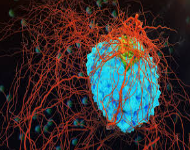Synthesis and In Silico Study of New Acetazolamide Derivatives Incorporating a 1,2,4-Triazole Moiety as Potential Carbonic Anhydrase Inhibitors and Anti-cancer Agents
Main Article Content
Abstract
A significant number of 1,2,4-triazole derivatives are known to possess numerous pharmacological properties. The present study aims to synthesize new acetazolamide derivatives with 1,2,4-triazole moiety and investigate their carbonic anhydrase inhibitory and anticancer activities in silico. Three acetazolamide derivatives having a 1,2,4-triazole moiety were synthesized from the reaction between acetazolamide and hydrazine monohydrate as starting materials. The interaction of the synthesized ligands with carbonic anhydrase XII (CAXII) enzyme (PDB code: 4QJW) a putative biomarker for solid tumors was investigated in silico via molecular docking simulation. The binding affinities of docked ligands with the target protein CAXII were reported in terms of S score and Root Mean Square Deviation (RMSD), which were calculated using the Molecular Operating Environment (MOE) software 2015 program. The docking results revealed a better binding affinity of the three test ligands (Sa, Sb, and Sc) for the target protein CAXII than the positive control ligand, acetazolamide. Of the three compounds, compound Sc showed the highest binding affinity with an S score of -7.0168. These observations suggest that the newly synthesized acetazolamide derivatives particularly compound Sc hold promise as carbonic anhydrase inhibitors, and anticancer agents targeting the CAXII enzyme.
Downloads
Article Details
Section

This work is licensed under a Creative Commons Attribution-NonCommercial-NoDerivatives 4.0 International License.
How to Cite
References
Siegel RL, Miller KD, Wagle NS, Jemal A. Cancer statistics, 2023. Ca Cancer J Clin. 2023; 73(1):17-48.
Ahmad FB and Anderson RN. The leading causes of death in the US for 2020. J Am Med Assoc. 2021; 18325(18):1829-30.
Ganesh K and Massague J. Targeting metastatic cancer. Nat Med. 2021; 27(1):34-44.
Vasir JK and Labhasetwar V. Targeted drug delivery in cancer therapy. Technol Cancer Res Treat. 2005; 4(4):363-374.
Wang X, Zhang H, Chen X. Drug resistance and combating drug resistance in cancer. Cancer Drug Resist. 2019; 2(2):141.
Tuğrak M, Gül Hİ, Sakagami H, Kaya R, Gülçin İ. Synthesis and biological evaluation of new pyrazole benzene-sulphonamides as potential anticancer agents and hCA I and II inhibitors. Turk J Chem. 2021; 45(3):528-539.
Cuffaro D, Nuti E, Rossello A. An overview of carbohydrate-based carbonic anhydrase inhibitors. J Enzyme Inhib Med Chem. 2020; 35(1):1906-1922.
Tonissen KF and Poulsen SA. Carbonic anhydrase XII inhibition overcomes P-glycoprotein-mediated drug resistance: A potential new combination therapy in cancer. Cancer Drug Resist. 2021; 4(2):343.
Haapasalo J, Nordfors K, Haapasalo H, Parkkila S. The expression of carbonic anhydrases II, IX and XII in brain tumors. Cancers. 2020; 12(7):1723.
Huwaimel BI, Jonnalagadda SK, Jonnalagadda S, Kumari S, Nocentini A, Supuran CT, Trippier PC. Selective carbonic anhydrase IX and XII inhibitors based around a functionalized coumarin scaffold. Drug Dev Res. 2023; 84(4):681-702.
Waheed A and Sly WS. Carbonic anhydrase XII functions in health and disease. Gene. 2017; 623:33-40.
Supuran CT. Therapeutic applications of the carbonic anhydrase inhibitors. Clin Prac. 2007; 4(3):355.
Qadir T, Amin A, Sharma PK, Jeelani I, Abe H. A review on medicinally important heterocyclic compounds. The Open Med Chem J. 2022; 16(1):e187410452202280.
Matin MM, Matin P, Rahman MR, Ben Hadda T, Almalki FA, Mahmud S, Ghoneim MM, Alruwaily M, Alshehri S. Triazoles and their derivatives: Chemistry, synthesis, and therapeutic applications. Front Mol Biosci. 2022; 9:864286.
Song MX and Deng XQ. Recent developments on triazole nucleus in anticonvulsant compounds: a review. J Enzyme Inhib Med Chem. 2018; 33(1):453-478.
Kumari M, Tahlan S, Narasimhan B, Ramasamy K, Lim SM, Shah SA, Mani V, Kakkar S. Synthesis and biological evaluation of heterocyclic 1,2,4-triazole scaffolds as 16.promising pharmacological agents. BMC Chem. 2021; 15:1-6.
Kaur R, Ranjan Dwivedi A, Kumar B, Kumar V. Recent developments on 1,2,4-triazole nucleus in anticancer compounds: a review. Anti-Cancer Agents Med Chem (Formerly Curr Med Chem-Anti-Cancer Agents). 2016; 16(4):465-489.
Gümrükçüoğlu NU, Imran M, Iqbal I. Synthesis, characterization and antimicrobial activity of some novel 4-amino-5-phenyl-4H-1,2,4-triazole-3-thiol derivatives. İstanbul J Pharm. 2023; 53(3):294-301.
Kapri KP, Singar SB, Khanal S, Shakya B. Synthesis of Schiff bases of 4-amino-5-(2-hydroxyphenyl)-4H-1,2,4-triazole-3-thiol as potent antimicrobial agents. Amrit Res J. 2020; 1(1):29-36.
Jubie S, Sikdar P, Antony S, Kalirajan R, Gowramma B, Gomathy S, Elango K. Synthesis and biological evaluation of some Schiff bases of [4-(amino)-5-phenyl-4H-1,2,4-triazole-3-thiol]. Pak J Pharm Sci. 2011; 24(2):109-112.
Naser NH, Alibeg AA, AbdAl-Zahra AJ. Design, synthesis, in silico study, and preliminary pharmacological evaluation of ibuprofen derivatives containing 1,3,4-Oxadiazole moiety. Mater Today: Proc. 2022; 65:2669-2675.
Abbas ZK, Naser NH, Atiya RN. In Silico Study of Novel Sulfonamide Derivatives Bearing a 1,2,4-Triazole Moiety Act as Carbonic Anhydrase Inhibitors with Promising Anti-Cancer Activity. Polski Merkuriusz Lekarski. 2023:527.
Falodun A, Siraj R, Choudhary MI. GC-MS Insecticidal Leaf essential oil of P. staudtii Hutch and DalzIcacinaceae). Trop J Pharm Res. 2009; 82:139-143.
Okolie NP, Falodun A, Oluseyi D. Evaluation of the antioxidant activity of root extract of pepper fruit (Dennetia tripetala), and its potential for the inhibition of Lipid peroxidation. Afr J Tradit Complement and Alternat Med. 2014; 11(3):221-227.




